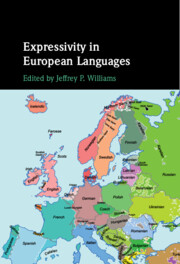Book contents
- Expressivity in European Languages
- Expressivity in European Languages
- Copyright page
- Contents
- Figures
- Tables
- Contributors
- 1 Introduction
- Uralic
- Germanic
- 4 Expressivity in Scots: A study of echo words
- 5 Reduplication as expressive morphology in German
- Hellenic
- Romance
- Celtic
- Vasconian
- Caucasian
- Comparative
- Index
- References
5 - Reduplication as expressive morphology in German
from Germanic
Published online by Cambridge University Press: 24 August 2023
- Expressivity in European Languages
- Expressivity in European Languages
- Copyright page
- Contents
- Figures
- Tables
- Contributors
- 1 Introduction
- Uralic
- Germanic
- 4 Expressivity in Scots: A study of echo words
- 5 Reduplication as expressive morphology in German
- Hellenic
- Romance
- Celtic
- Vasconian
- Caucasian
- Comparative
- Index
- References
Summary
This chapter surveys various types of reduplicative word formation in German and discusses their morpho-phonological regularities as well as their use conditions and the iconically-expressive meanings attributed to them. It is argued that the repetitive, formally redundant forms pose strict conditions on their use, making reduplication prone to familiar and non-standard language use. At the same time, reduplications are phonologically conspicuous markers for expressive meaning dimensions. Reduplication in German especially evokes semantic flavours related to smallness, playfulness, lack of seriousness, and jocular depreciation. The survey suggests that, in spite of the foregrounding of the expressive and poetic function, the various types of reduplication are morphologically quite regular. Previous accounts on reduplication in German that deem these words to be “extra-grammatical” are therefore rejected.
- Type
- Chapter
- Information
- Expressivity in European Languages , pp. 103 - 120Publisher: Cambridge University PressPrint publication year: 2023



